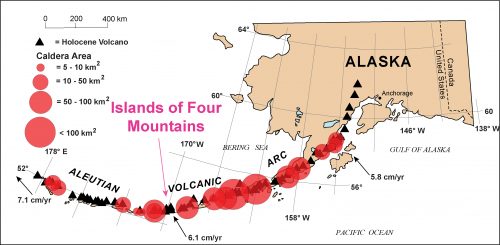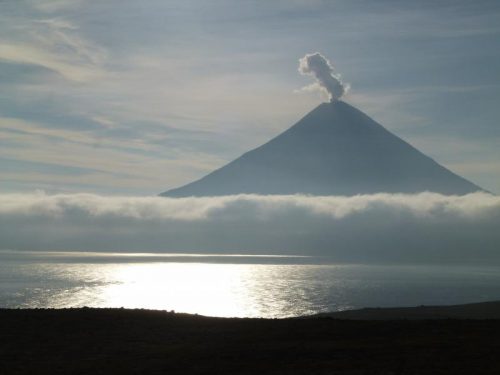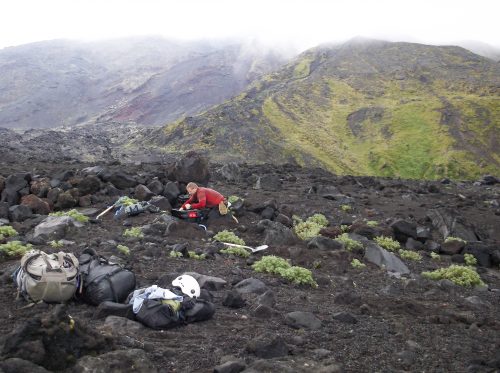Cluster of Alaska islands could be single giant volcano
December 3, 2020
LJ Evans
907-474-2737

A small group of volcanic islands in Alaska's Aleutian Islands might be part of a single, undiscovered giant volcano, say scientists presenting their research next week at the 2020 American Geophysical Union Fall Meeting.
If the researchers’ suspicions are correct, the newfound volcanic caldera would belong to the same category of volcanoes as the Yellowstone Caldera and others that have had super-eruptions with severe global consequences.
The Islands of the Four Mountains in the central Aleutians is a tight group of six stratovolcanoes named Carlisle, Cleveland, Herbert, Kagamil, Tana and Uliaga. Stratovolcanoes are what most people envision when they think of a volcano: a steep conical mountain with a banner of clouds and ash waving at the summit. They can have powerful eruptions, like that of Mount St. Helens in 1980, but these are dwarfed by far less frequent caldera-forming eruptions.
Researchers from a variety of institutions and disciplines have been studying Mount Cleveland, the most active volcano of the group. They are trying to understand the nature of the Islands of the Four Mountains. They have gathered multiple pieces of evidence showing that the islands could belong to one interconnected caldera.

Unlike stratovolcanoes, which tend to tap small to modestly sized reservoirs of magma, a caldera is created by tapping of a huge reservoir in the Earth’s crust. When the reservoir’s pressure exceeds the strength of the crust, gigantic amounts of lava and ash are released in a catastrophic episode of eruption.
Caldera-forming eruptions are the most explosive volcanic eruptions on Earth, and they often have had global effects. The ash and gas they put into the atmosphere can affect Earth’s climate, and even trigger social upheaval. For example, the eruption of an Aleutian volcano, Okmok, in the year B.C. 43 was recently implicated in the fall of the Roman Republic.
The proposed caldera underlying the Islands of the Four Mountains would be even larger than Okmok. If confirmed, it would become the first to be discovered in the Aleutians that is hidden underwater, said Diana Roman of the Carnegie Institution for Science in Washington, D.C., one of the authors of the study.
“We’ve been scraping under the couch cushions for data,” said Roman, referring to the difficulty studying such a remote place. “But everything we look at lines up with caldera in this region.”
While conducting geological field work in the summers of 2014 and 2015 on Chuginadak Island, where Cleveland and Tana volcanoes are located, Pavel Izbekov from the Geophysical Institute at the University of Alaska Fairbanks, Kirsten Nicolaysen from Whitman College and their colleagues kept finding interesting rocks. They looked like classic ignimbrites.
“Ignimbrites are products of very large, catastrophic caldera-forming events,” Izbekov said. “They are very different from typical products of small volcanic eruptions.”
Izbekov mentioned these observations last spring when John Power, a researcher with the U.S. Geological Survey affiliated with UAF's Alaska Volcano Observatory, shared the geophysical data from his group’s work at Mount Cleveland.

“He was excited as it actually matched his own and Diana Roman’s conclusions,” Izbekov said. “This is a great case in which the results of geophysical and geological investigations line up.”
Despite all these signs, Roman, along with Power, the study’s lead author, maintain that the caldera's existence is not yet proven. To do that, the study team will need to return to the islands and gather more direct evidence to fully test their hypothesis.
“Our hope is to return to the Islands of Four Mountains and look more closely at the seafloor, study the volcanic rocks in greater detail, collect more seismic and gravity data, and sample many more of the geothermal areas,” said Roman.
The caldera hypothesis might help explain the frequent explosive activity seen at Mount Cleveland, Roman said.
Mount Cleveland has arguably been the most active volcano in North America for at least the past 20 years. It has produced ash clouds as high as 15,000 and 30,000 feet (above sea level). These eruptions pose hazards to aircraft traveling the busy air routes between North America and Asia.
“It does potentially help us understand what makes Cleveland so active,” Power agreed. “It can also help us understand what type of eruptions to expect in the future and better prepare for their hazards.”
This work was supported by the National Science Foundation's Office of Polar Programs, the NSF-funded GeoPrisms Program, the U.S. Geological Survey and the Deep Carbon Observatory.
ADDITIONAL CONTACTS:
Pavel Izbekov, 907-474-5269, peizbekov@alaska.edu; Diana C. Roman, 202-478-8834, droman@carnegiescience.edu; John Power, 907-786-7426, jpower@usgs.gov
Click here for an abstract of the Four Mountains research paper from the American Geophysical Union conference.


